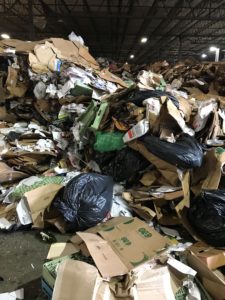Is the recycling industry coming to an end? Why all this talk?
For the past few years you may have noticed any number of media articles addressing the downturn of the recycling markets. Some have even gone so far as to state that recycling is coming to an end. Is the recycling industry, something that has existed in the US for over a hundred years, actually ending?
The majority of this media coverage is just hype; exaggerated claims that we will soon have nowhere to go with our recyclable materials. This is partially true, however by no means do the recent changes in recycling markets create a situation where we will no longer be able to recycle.
What is impacting the US recycling markets? The first is what China refers to as their “National Sword” policy. (You can read our articles about the policy here, here and here.) In an effort to reduce pollution in their country the Chinese government has implemented bans on the import of low-grade recyclable material s.
s.
Many will ask, if it’s being recycled now, how can it possibly result in pollution?
First – is the way this material is collected in the US. The US waste industry promoted and began to implement “single stream ” recycling in the late 1970’s. This allowed households to toss all of the recyclables into one bin for the municipality to collect curbside. This process was purported to save time, increase recycling rates, and lower associated expenses for the waste industry. It was an “easy” sell to cities and towns. They were also given the opportunity to “share” in the revenue generated by the sale of these recyclables, depending on market conditions.
These programs expanded throughout the US as well as other parts of the world. The waste industry invested millions of dollars in equipment and technology designed to cost effectively sort this commingled waste. As long as markets existed for these facilities’ end-products, everything worked.
The problem was created when the largest consumer of recycled products in the world, China, realized that 20-30% of the recyclables they were importing was not recyclable, due to excessive amounts of contamination.
But what about the millions of dollars invested by the waste industry to properly sort this material? The problem was that recycling plants received contaminated material. Broken glass was found in recyclable paper, plastics contained steel or even more glass. So much so that consumers of this material could not use 20-30% of the products they were purchasing. THIS was creating the pollution problems China was attempting to eliminate.
On top of all this many users of these single stream systems did not properly sort the “wanted” from the “unwanted” material – creating more contamination. This only escalated the problem.
What happened when China refused to accept this material? Prices for the recyclable commodities dropped dramatically as the “demand” side of the “supply and demand” economics of recycling opted-out, almost overnight. This resulted in municipalities now having to “pay” for their recycling service, rather than share in any possible revenue.
Of course the reaction by the waste industry and the generators of these commodities? Find alternative outlets – at any cost.
Recyclable material did find outlets, however it still contained levels of contamination – and contributed to the solid waste and potential pollution problems in these other countries. India recently announced that they will be banning the import of recyclable plastics, further escalating the problem. Where does it go from here?
There will always be a worldwide recycling industry. There is, and always will be, markets for clean, properly separated paper, plastics, and metals. These materials have value – and will always be purchased and recycled by various worldwide consumers. It is the contaminated, low-grade material that we “want” to be recycled that will end up as waste instead.
How does this leave the US recycling industry? For those generators that “source separate” their materials, and generate clean material, there should always be an outlet and long-term end market. For single stream generated material, that presents another problem.
What about these multi-million dollar sorting systems that process 40-50 tons per hour of commingled, single stream recycling? Will they continue to operate if they are only able to generate contaminated material? Will they invest more, in new technologies in an attempt to generate a marketable end commodity? At what price?
These are difficult decisions for any operation of this size. Will they generate a saleable commodity, will they be guaranteed an end market, and will the value of this material justify the expense and processing cost?
Time will tell – however regardless of how this plays out – recycling will continue.

